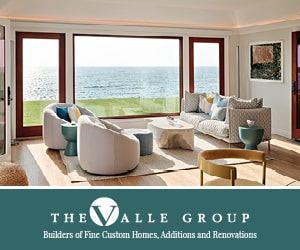
Green Living
Cape Cod Home / Spring 2015 / Home, Garden & Design, People & Businesses
Writer: Mary Stanley / Photographer: Dan Cutrona and Stacey Hedman
Green Living

Cape Cod Home / Spring 2015 / Home, Garden & Design, People & Businesses
Writer: Mary Stanley / Photographer: Dan Cutrona and Stacey Hedman
In 2015, green living has come out of the shade on Cape Cod and the Islands. Everywhere you look, there are sustainable options for those who want to protect and nourish our fragile coastal environment. From the ground up, architects and builders offer homes of every genre that work with each homeowner’s lifestyle and complement surrounding land and sea. Interior decorators provide furnishings that are eco-friendly and that will endure for generations. Local retailers and artisans offer innovative furnishings like light fixtures created with weathered lobster pots. In 2015, a whole rainbow of green options are available for homeowners on Cape Cod, Martha’s Vineyard, and Nantucket. Enjoy our special spring-time guide on just how easy it is to go green!

Photo by: Adpe Photo / ShutterStock

Coastal Eco-Decor
Cape and Islands contractors and decorators share their favorite environmentally sensitive materials and products.
Choosing eco-friendly materials for the design and furnishings of a home today has become less of a political statement and more of a mainstream choice. As more and more homeowners search for products that contain no toxins and select furnishings and decorative items made from renewable or recyclable materials, trends in decorating style have evolved. The more we learn about the chemicals used in the finish for countertops and flooring, the more attractive products containing none of those compounds have become. Decorating and designing homes using eco-friendly products that reduce our carbon footprint allows us all to better enjoy our Cape Cod sanctuaries—and to breathe a little bit easier.

Photo by: Dan Cutrona
The use of reclaimed or repurposed materials is just one component of creating a green home design and this practice reflects Cape Cod’s heritage, especially if one considers the old adage, “waste not, want not.” Yankee craftsmen have known for years that reusing materials not only makes good economical sense—it makes sense in terms of creating a unique and distinctive style. Tom Adams, owner of Cataumet Sawmill in Falmouth, appreciates the value of this practice and has been using reclaimed wood to mill his high-quality hardwood flooring since 1986.
Although Cataumet’s customized floors come in a variety of woods and finishes, antique heart pine is especially popular—but its availability is extremely limited. “It’s a finite product and it is getting harder and harder to find,” Adams says. Because of its limited supply, Adams says it is essential that the wood come from a source other than the forest. One of the best places to find this coveted material he says, is from old buildings that are being torn down. “New England is the best source of reclaimed wood. We are getting a load of lumber today from an old warehouse in Dorchester that was recently demolished,” Adams says.

Photo by: Dan Cutrona
While some of Adams’ customers are purchasing their floors and cabinets from Cataumet Sawmill because of the green practices Adams employs in every phase of the manufacturing process—even the sawdust is repurposed—many, he says, are choosing his products because of the unique beauty and quality of the materials. “Most of our customers come to us because they want something that is one-of-a-kind,” he says.

Choosing eco-friendly materials does not mean compromising on style or quality. In fact, some of today’s most environmentally sensitive designs use top quality materials that offer equally distinctive style. Nicole Goldman, owner of G Green Design Center in Mashpee Commons recently designed a kitchen for a professional nutritionist who is passionate about the food she makes as well as the materials on which she prepares her meals.

Photo by: Dan Cutrona
The kitchen design includes recycled glass, concrete countertops, bamboo cabinets, and cork flooring. The end result represents the truest definition of form meeting function. In addition to being anti-microbial and anti-bacterial and requiring nothing more than soap and water in terms of maintenance, the tiny specks of glass in the concrete countertops create a diamond-like shimmer that plays off of the teal-toned recycled glass backsplash, all of which complement a vintage 1950’s style chandelier that hangs above the dining room table. The homeowner carried the eco-friendly design right down to the cabinet knobs and drawer pulls choosing recycled glass for the knobs and a low-lead pewter for the handles. Shimmery glass insets in the upper level cabinets tie the design together.
While the use of these recycled materials would have been enough to qualify the design as environmentally sensitive, the homeowner took the project to the next level with her choice of appliances. An urban cultivator for growing and harvesting wheat grass, a special water purifying system that not only removes toxins but also alkalizes the water, a dehydrator for drying out fruits and vegetables, a compost bin sunk in to a work island, and a large steam oven all serve to emphasize healthy living in this kitchen.
“I wouldn’t say the design is over the top in terms of eco-friendly, but it is a very exceptional kitchen. It is a reflection of the homeowner’s energy and enthusiasm. The whole kitchen is centered around her nutritional ethos,” Goldman says.

The choices in eco-friendly materials go far beyond the structural elements of a design—they can be carried onto the very walls and ceiling of a home as well. Toby Leary owner of TL Fine Woodworking in Hyannis, stocks Farrow & Ball Paints for his customers, which are available in a stunning array of colors and contain no harmful chemicals. “Farrow & Ball is one of the only companies that has managed to get zero—or close to zero—[Volatile Organic Compounds] VOCs in their paint,” says Luke Ehlers, Farrow & Ball’s gallery manager and office manager for TL Fine Woodworking.

Photo by: Dan Cutrona
“You can paint a room and there is very little odor from the paint. This is especially comforting for parents who may be painting a child’s room, or any room in the house for that matter—it allays any concerns they may have about the odor affecting their children’s health,” Ehlers says.
Eliminating the chemicals in the paint, Ehlers says, does not mean compromising on quality. In fact, he says, Farrow & Ball is a very high-end paint that goes on extremely smoothly and provides exceptional color. “Some people are tempted not to use the second coat, but the second coat really makes a difference. It is the finishing touch in terms of providing the richness and depth of color and producing the truest color,” he says.
Clean up is almost as environmentally friendly as the paint itself. “This paint is water-based, so it comes off of brushes and rollers with just water. No turpentine is needed,” Ehlers notes.
Farrow & Ball also offers wallpapers that—through a hand-brushed technique—make the most of the high-quality paint in the wallpaper designs. “Wallpaper is trending a little bit more now. Though it is not as popular as paint, we are seeing a lot more people leaning toward this material and a lot of designers are coming in asking for the books. Wallpaper adds a little life to a room. It can give a little more character,” Ehlers says.

Materials do not need to be expensive for eco-decor designs. Interior designer Michele Chagnon-Holbrook, owner of Casabella Interiors in East Sandwich, says environmentally informed interior design can start with something as simple as “green” accent pieces for a particular space. “Soy candles made from locally grown soy are a great alternative to less eco-friendly candles,” says Chagnon-Holbrook. “The soy candles burn differently than wax candles, burning all the way down without hollowing out. Other eco-friendly accent pieces can include recycled wood frames with inspirational messages inside and old shutters that have been repurposed into decorative wall hangings. Green design can be as simple as repurposing something old into something that is new and creative.”
For those who want the ambiance that live plants bring to a design, but may not have the time or the talent to care for botanicals, Casabella carries a line of preserved greenery that Chagnon-Holbrook says offers all of the desired visual impact of live plants without the work. The designer emphasizes that these faux botanicals should not be confused with the silk flowers from the ‘80s and ‘90s.

Photo by: Stacey Hedman
“These flowers and foliage feel like a live plant, but they never shed and need no watering,” she explains. “They are ideal for people who like having plants in the home, but cannot be there every week to provide watering and care.” Created with a special preservative process, these stunning botanicals retain their color for five to ten years. “They are the next best thing to living plants,” the designer says. Other materials that lend themselves to green décor include grass cloth wallpaper, jute rugs, and viscose—a silk material made from bamboo. “We are seeing a lot of viscose, especially at the home shows,” says Chagnon-Holbrook.

Designer Kevin Miller who co-owns Shor Home Furnishings in Provincetown with designer Herbert Acevedo, notes that the simplistic and natural look of today’s eco-friendly designs are also a reflection of the style homeowners seek for their coastal getaways. “People are gravitating toward neutral tones and healthy fabrics such as cotton and linens, which are breathable,” Miller says.
From accessories to furniture, Shor carries a variety of eco-friendly items. “We have an Italian-designed kidney-shaped coffee table made of renewable wood. It’s beautiful. All of our overhead lights and table lamps use LED bulbs and we encourage our clients and customers to purchase LED lights,” says Miller. “We also have dishes, trays, and other accessories made from recycled aluminum.”
David Shinn, owner of VU Design in Hyannis points out that eco-friendly options are a matter of personal choice. “Some people want furniture made from renewable wood products and some want their eco-friendly furniture to be green right down to ensuring that the sheep, whose wool is used for the fabrics, were raised on sustainable farms. It can get pretty specific,” he says.
Shinn says he has seen an uptick in the number of people who want to include environmentally sensitive products in their home décor. “The more educated people become about green practices and some of the compounds contained in certain products, the more they look for organic materials,” he says. Some of these materials are far more superior. “Hemp and jute are natural fibers and they are incredibly strong and breathe better.”
Many of today’s popular decorating trends are a reflection of the rise in popularity of green materials. “Linen, which is a natural fabric, is huge and it has been that way for a few years. There is a natural palette to it and there is a real organic feel to it. People are drawn to texture. There is also a cotton duck fabric that is washable and is a great compromise between something that is totally organic and uses only water-based dyes and a cotton-poly blend that is not organic,” Shinn says.
Shinn notes that trends in accessories are also a reflection of eco-friendly attitudes. “We are seeing a lot of natural metals, untreated wall woods, and the use of reclaimed or repurposed woods such as barn wood. What we used to consider junk is now considered stylish. I think it’s a look that is going to be around for a while. It’s a whole new classic look.”




